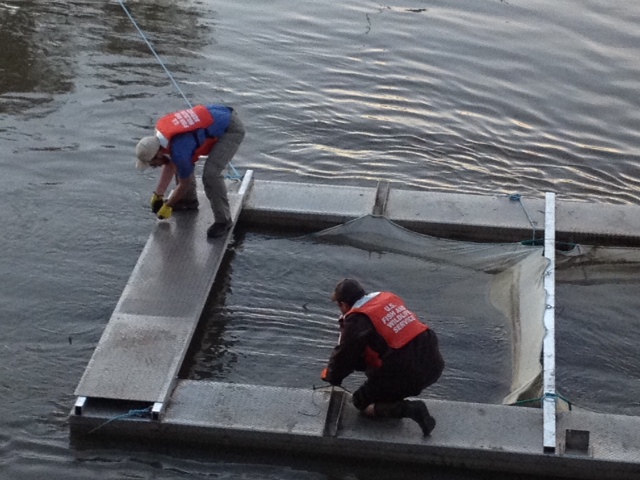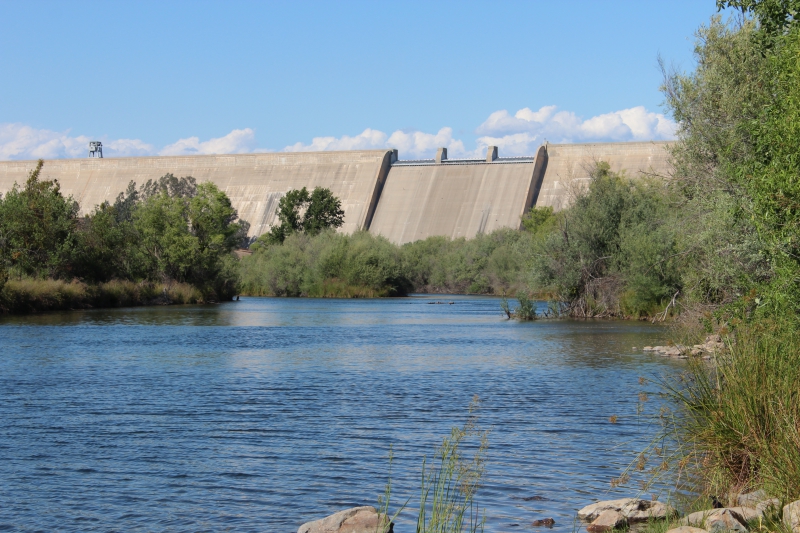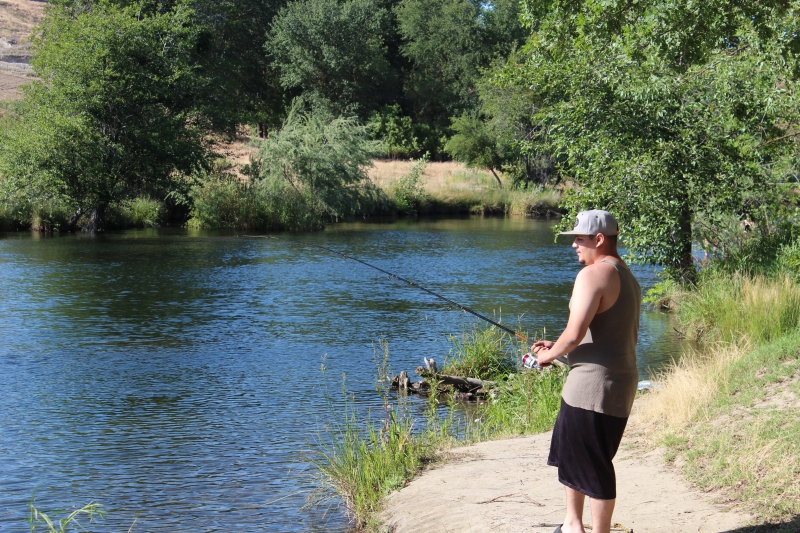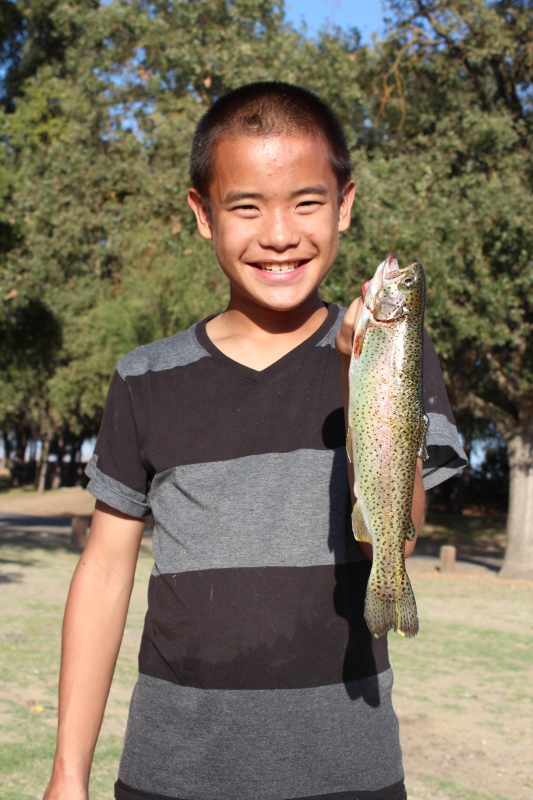From the Open-Publishing Calendar
From the Open-Publishing Newswire
Indybay Feature
Feds Release Spring-Run Chinook Salmon Into San Joaquin River
In a historic moment, the Bureau of Reclamation and the U.S. Fish and Wildlife Service on April 17 and 18 released 54,000 hatchery-produced juvenile spring-run Chinook salmon into the San Joaquin River as part of the implementation of the San Joaquin River Restoration Program.
Photo of biologists releasing spring run Chinook salmon from an acclimation pen into the San Joaquin River below Hills Ferry. Photo courtesy of U.S. Fish and Wildlife Service.
Photo of biologists releasing spring run Chinook salmon from an acclimation pen into the San Joaquin River below Hills Ferry. Photo courtesy of U.S. Fish and Wildlife Service.

Feds Release Spring-Run Chinook Salmon Into San Joaquin River
by Dan Bacher
The scenic San Joaquin River below Friant Dam has been a popular place for families to fish for rainbow trout and other species for years, but the river is now in transition to becoming an anadromous fishery as federal and state governments and environmental groups work to restore spring run-Chinook salmon to the river.
It is expected that by 2017 that spring run Chinooks, absent from the river since the building of Friant Dam in the 1940s resulted in the dewatering of 60 miles of the river except for in very wet water years, will again be ascending to spawn in this section of river. At the same time, the plants of catchable rainbow trout that the Department of Fish and Wildlife made in the river for many years have been discontinued.
In a historic moment, the Bureau of Reclamation and the U.S. Fish and Wildlife Service on April 17 and 18 released 54,000 hatchery-produced juvenile spring-run Chinook salmon into the San Joaquin River as part of the implementation of the San Joaquin River Restoration Program.
The Restoration Program is a comprehensive long-term effort to restore flows to the San Joaquin River from Friant Dam to the confluence of the Merced River, restoring a self-sustaining Chinook salmon fishery in the river while reducing or avoiding adverse water supply impacts from those flows, according to Margaret Gidding of the U.S. Fish and Wildlife Service.
The original run of spring Chinooks became extinct, in spite of efforts by a brave DFG biologist to rescue the remaining fish. So the state had to obtain spring-run Chinooks from the Feather River Hatchery in Oroville to release near the confluence of the Merced and San Joaquin rivers near Newman to reintroduce the fish subspecies.
Before the fish were released, the juvenile fish were acclimated for several days in holding pens in the river below Friant Dam and then trucked to the release site, according to Gerald Hatler, California Department of Fish and Wildlife Environmental Program Manager. A new hatchery to raise spring run chinooks is being built on the property adjacent to the San Joaquin River Fish Hatchery.
Federal officials said the release effort will provide an opportunity to carryout fisheries studies while contributing to the long-term reintroduction of spring-run salmon to the San Joaquin River as called for in the San Joaquin River Settlement.
“As part of this effort, some of these juvenile spring-run are anticipated to return to the river as adults in spring 2017. However dry year conditions will likely impact the number of returning fish,” Gidding noted.
The USFWS and Reclamation are prepared to trap and transport the returning adults up river, if conditions are such that they cannot make it on their own, according to Gidding.
The returning adults will then be monitored to determine what parts of the river they use, their survival over the summer, and where they spawn in the fall of 2017. This information will help further inform future spring-run reintroduction efforts.
“This is an important study effort for the Restoration Program that does not impact water supply,” said David Murillo, Director of Reclamation’s Mid-Pacific Region. “We are hopeful that in three years, some of these juveniles return to the San Joaquin River as adults so that we learn more toward the long-term reintroduction of this species.”
The released spring-run are considered an “experimental population” under the Endangered Species Act and are exempted from the take prohibitions by the Central Valley Project and the State Water Project, consistent with the Endangered Species Act rule package issued by the National Marine Fisheries Service on December 31, 2013.
The California Department of Fish and Wildlife (CDFW) concurred with the federal regulations under special provisions of the California Endangered Species Act that apply to the San Joaquin River Restoration Program on March 17, 2014. The release will not impact water supply for any water user nor will any additional water releases be made for the benefit of these fish, said Gidding.
“Today’s salmon release is a monumental step forward for California’s fishing economy and the health of the state’s second largest river, particularly as we face a historic drought,” said Monty Schmitt, Senior Scientist with the Natural Resources Defense Council. “Even in the driest years, it is essential for the livelihood of communities in the Central Valley to protect the health of our rivers and fisheries while supporting the region’s agricultural economy.”
The restoration plan has resulted in a change on the river in fishing regulations from a resident rainbow trout to an anadromous fishery.
“Starting January 1 of this year, we will be no longer planting rainbow trout in the river below the dam,” said Greg Pape, manager of the San Joaquin River Fish Hatchery. “However, there are still a lot of wild trout that I expect to reproduce naturally. Also, there are populations of crappie, black bass and channel catfish in the river.”
For many years, the CDFW planted around 18,000 pounds of catchable rainbows in the San Joaquin throughout the year. Now the hatchery will be shifting these fish to other fisheries, including the Sycamore Island Pond located off the San Joaquin below Highway 41. The hatchery will be planting around 7,000 pounds of rainbows there annually from November through early April when the water is still cool enough to plant trout.
Pape added that the ponds in the recreation area also feature warm water species including black bass, crappie and channel catfish to pursue.
Sycamore Island, located along the north side of the San Joaquin River just two miles west of Highway 41 north of Fresno, is operated by the San Joaquin River Parkway and Conservation Trust. It is open to the public for fishing and recreation on Fridays, weekends, and state holidays from February through mid-November.
The regulations on the river from Friant Dam downstream to the Highway 140 Bridge were changed in 2013 from five trout per day to 2 hatchery trout or hatchery steelhead per day and 4 hatchery trout or hatchery steelhead in possession. Since the river is no longer planted with catchable rainbows, the river has transitioned from a put and take trout fishery to a catch and release wild trout fishery.
The restoration program was made possible by a settlement reached in 2006 in the 18-year-old lawsuit filed in 1988 by over a dozen fishing groups, including the California Sportfishing Protection Alliance and United Anglers of California, and environmental groups. The settlement guaranteed an increasing amount of "restoration flows" to allow salmon and steelhead to successfully spawn and rear in the San Joaquin.
The Bureau of Reclamation, the operator of Friant Dam, began releasing those restoration flows in 2009. However, restoration flows over the past several years were reduced, due to seepage problems on landowners land. There are no restoration flows this year because of the drought.
For more information, go to: http://www.restoresjr.net/
by Dan Bacher
The scenic San Joaquin River below Friant Dam has been a popular place for families to fish for rainbow trout and other species for years, but the river is now in transition to becoming an anadromous fishery as federal and state governments and environmental groups work to restore spring run-Chinook salmon to the river.
It is expected that by 2017 that spring run Chinooks, absent from the river since the building of Friant Dam in the 1940s resulted in the dewatering of 60 miles of the river except for in very wet water years, will again be ascending to spawn in this section of river. At the same time, the plants of catchable rainbow trout that the Department of Fish and Wildlife made in the river for many years have been discontinued.
In a historic moment, the Bureau of Reclamation and the U.S. Fish and Wildlife Service on April 17 and 18 released 54,000 hatchery-produced juvenile spring-run Chinook salmon into the San Joaquin River as part of the implementation of the San Joaquin River Restoration Program.
The Restoration Program is a comprehensive long-term effort to restore flows to the San Joaquin River from Friant Dam to the confluence of the Merced River, restoring a self-sustaining Chinook salmon fishery in the river while reducing or avoiding adverse water supply impacts from those flows, according to Margaret Gidding of the U.S. Fish and Wildlife Service.
The original run of spring Chinooks became extinct, in spite of efforts by a brave DFG biologist to rescue the remaining fish. So the state had to obtain spring-run Chinooks from the Feather River Hatchery in Oroville to release near the confluence of the Merced and San Joaquin rivers near Newman to reintroduce the fish subspecies.
Before the fish were released, the juvenile fish were acclimated for several days in holding pens in the river below Friant Dam and then trucked to the release site, according to Gerald Hatler, California Department of Fish and Wildlife Environmental Program Manager. A new hatchery to raise spring run chinooks is being built on the property adjacent to the San Joaquin River Fish Hatchery.
Federal officials said the release effort will provide an opportunity to carryout fisheries studies while contributing to the long-term reintroduction of spring-run salmon to the San Joaquin River as called for in the San Joaquin River Settlement.
“As part of this effort, some of these juvenile spring-run are anticipated to return to the river as adults in spring 2017. However dry year conditions will likely impact the number of returning fish,” Gidding noted.
The USFWS and Reclamation are prepared to trap and transport the returning adults up river, if conditions are such that they cannot make it on their own, according to Gidding.
The returning adults will then be monitored to determine what parts of the river they use, their survival over the summer, and where they spawn in the fall of 2017. This information will help further inform future spring-run reintroduction efforts.
“This is an important study effort for the Restoration Program that does not impact water supply,” said David Murillo, Director of Reclamation’s Mid-Pacific Region. “We are hopeful that in three years, some of these juveniles return to the San Joaquin River as adults so that we learn more toward the long-term reintroduction of this species.”
The released spring-run are considered an “experimental population” under the Endangered Species Act and are exempted from the take prohibitions by the Central Valley Project and the State Water Project, consistent with the Endangered Species Act rule package issued by the National Marine Fisheries Service on December 31, 2013.
The California Department of Fish and Wildlife (CDFW) concurred with the federal regulations under special provisions of the California Endangered Species Act that apply to the San Joaquin River Restoration Program on March 17, 2014. The release will not impact water supply for any water user nor will any additional water releases be made for the benefit of these fish, said Gidding.
“Today’s salmon release is a monumental step forward for California’s fishing economy and the health of the state’s second largest river, particularly as we face a historic drought,” said Monty Schmitt, Senior Scientist with the Natural Resources Defense Council. “Even in the driest years, it is essential for the livelihood of communities in the Central Valley to protect the health of our rivers and fisheries while supporting the region’s agricultural economy.”
The restoration plan has resulted in a change on the river in fishing regulations from a resident rainbow trout to an anadromous fishery.
“Starting January 1 of this year, we will be no longer planting rainbow trout in the river below the dam,” said Greg Pape, manager of the San Joaquin River Fish Hatchery. “However, there are still a lot of wild trout that I expect to reproduce naturally. Also, there are populations of crappie, black bass and channel catfish in the river.”
For many years, the CDFW planted around 18,000 pounds of catchable rainbows in the San Joaquin throughout the year. Now the hatchery will be shifting these fish to other fisheries, including the Sycamore Island Pond located off the San Joaquin below Highway 41. The hatchery will be planting around 7,000 pounds of rainbows there annually from November through early April when the water is still cool enough to plant trout.
Pape added that the ponds in the recreation area also feature warm water species including black bass, crappie and channel catfish to pursue.
Sycamore Island, located along the north side of the San Joaquin River just two miles west of Highway 41 north of Fresno, is operated by the San Joaquin River Parkway and Conservation Trust. It is open to the public for fishing and recreation on Fridays, weekends, and state holidays from February through mid-November.
The regulations on the river from Friant Dam downstream to the Highway 140 Bridge were changed in 2013 from five trout per day to 2 hatchery trout or hatchery steelhead per day and 4 hatchery trout or hatchery steelhead in possession. Since the river is no longer planted with catchable rainbows, the river has transitioned from a put and take trout fishery to a catch and release wild trout fishery.
The restoration program was made possible by a settlement reached in 2006 in the 18-year-old lawsuit filed in 1988 by over a dozen fishing groups, including the California Sportfishing Protection Alliance and United Anglers of California, and environmental groups. The settlement guaranteed an increasing amount of "restoration flows" to allow salmon and steelhead to successfully spawn and rear in the San Joaquin.
The Bureau of Reclamation, the operator of Friant Dam, began releasing those restoration flows in 2009. However, restoration flows over the past several years were reduced, due to seepage problems on landowners land. There are no restoration flows this year because of the drought.
For more information, go to: http://www.restoresjr.net/
Add Your Comments
We are 100% volunteer and depend on your participation to sustain our efforts!
Get Involved
If you'd like to help with maintaining or developing the website, contact us.
Publish
Publish your stories and upcoming events on Indybay.
Topics
More
Search Indybay's Archives
Advanced Search
►
▼
IMC Network





